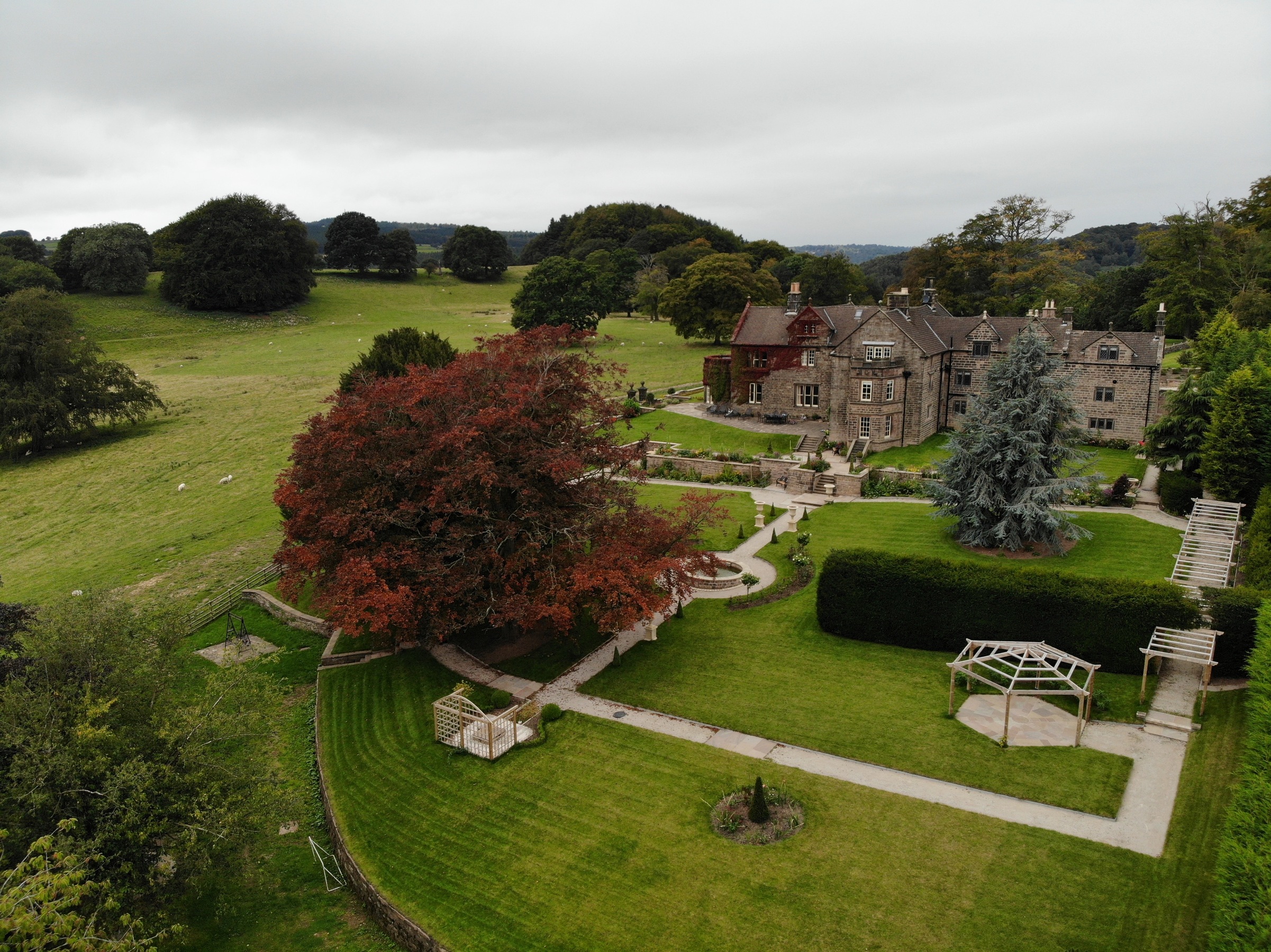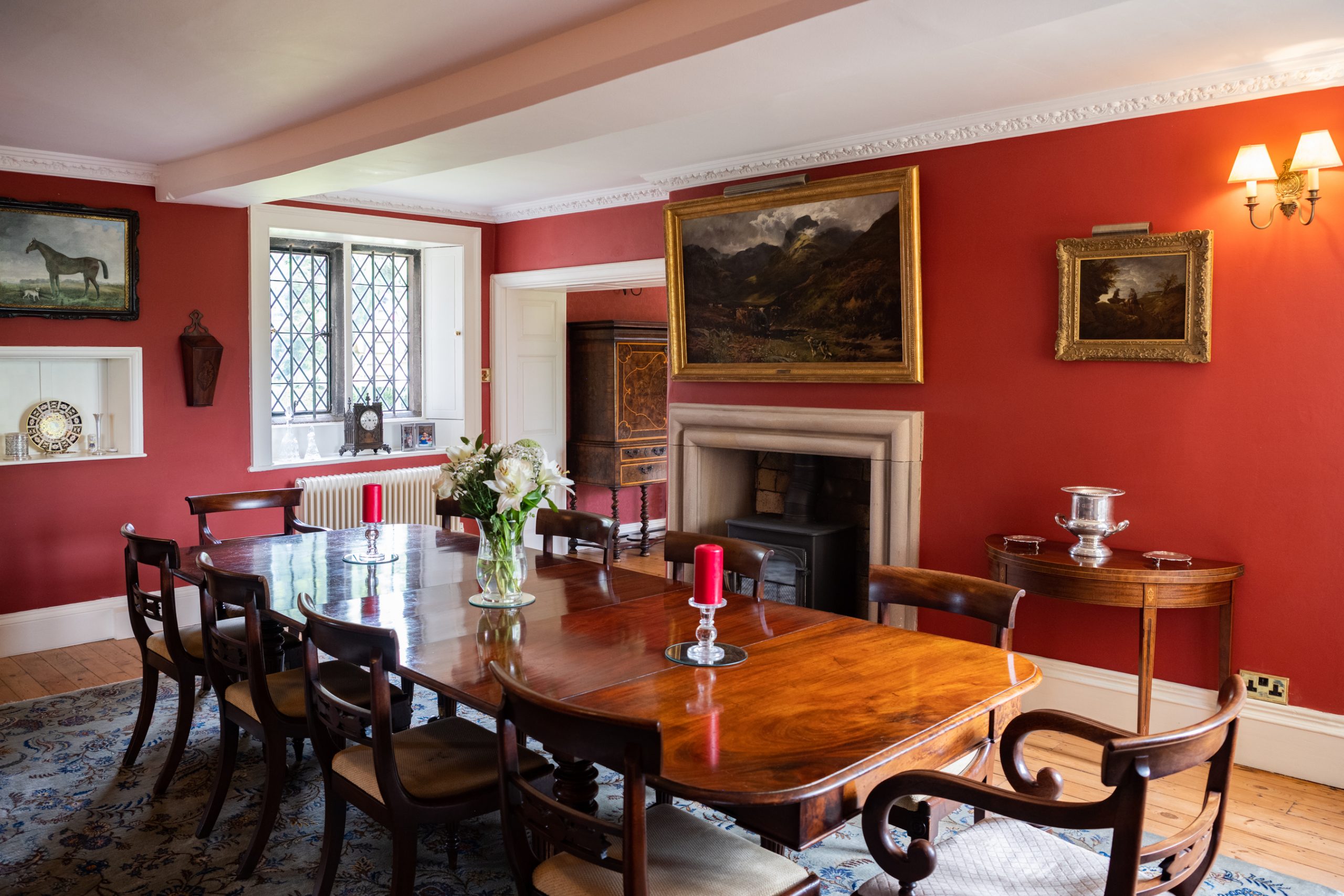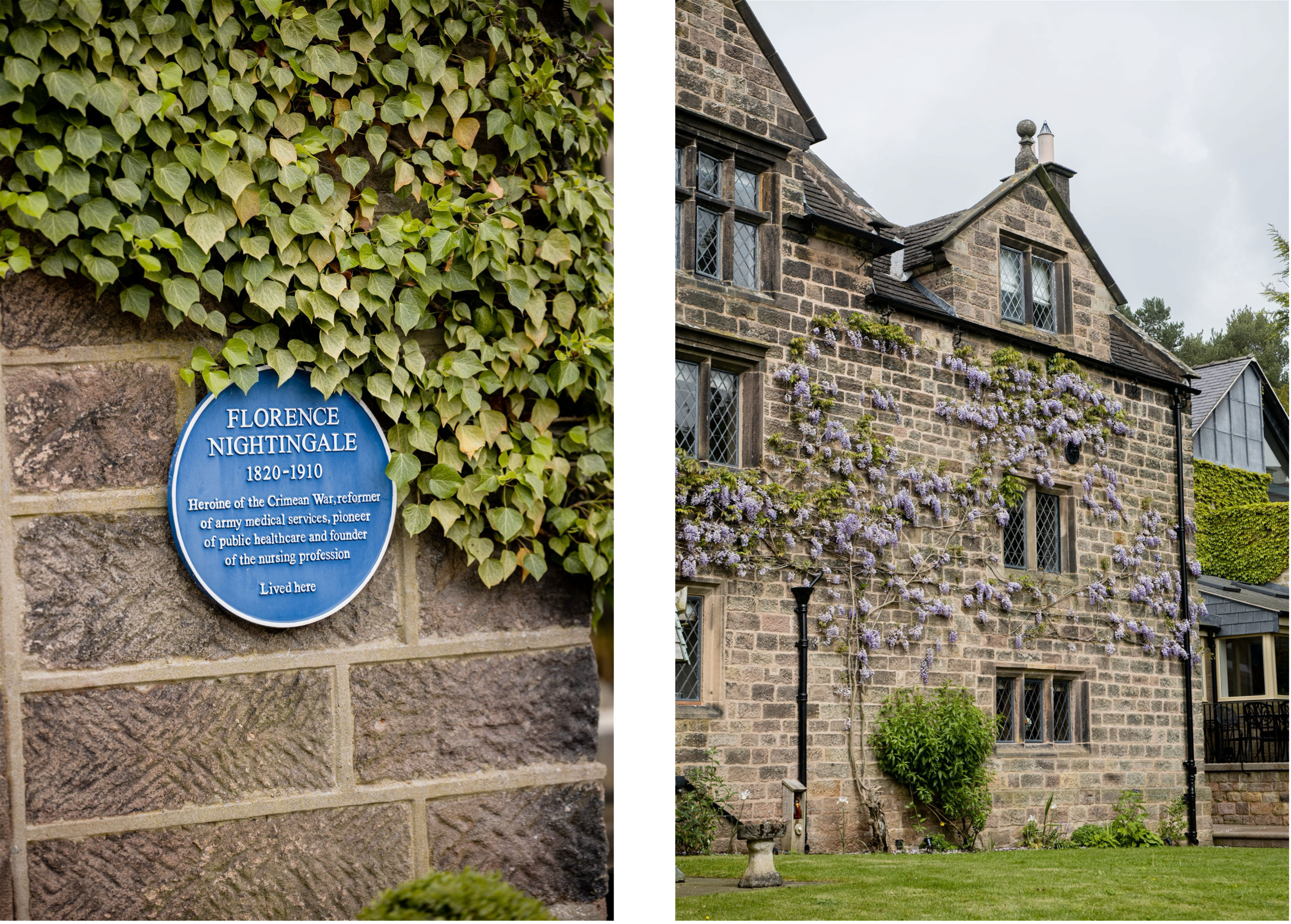















































Lea Hurst is a fantastic Grade II listed historic family home in an upliftingly elevated location with splendid panoramic views over the Derwent Valley to one side and mature parkland to the other.
For more information please contact Seb at seb@bluebookagency.com or call 07535150888
For full details please download our Brochure




Chapter One
Lea Hurst is a fantastic Grade II listed historic family home in an upliftingly elevated location with splendid panoramic views over the Derwent Valley to one side and mature parkland to the other.
A thorough and assiduously researched renovation has been conducted by the current owners who have employed local craftsmen to sensitively restore Lea Hurst and enhance its original purpose as a special family home, whilst also celebrating its illustrious former inhabitant, Florence Nightingale.
The result is a beautifully finished home with excellent flow and quintessential gothic features throughout.
A 5-bar wooden gate marks the entrance to the recently reinstated original front drive which winds a long path through impressive undulating parkland planted with a picturesque assortment of mature trees.
Lea Hurst itself is located in an elevated position on a hillside overlooking the glorious Derwent Valley below and it remains hidden from sight until halfway down the drive when it is revealed peeping over the brow of the hill as the drive rounds a curve and approaches the final stretch up to the house.
The front drive leads through a gateway into an inner walled courtyard with turning circle at the front of the house.
Ground Floor
The pretty gothic arched front door with shutters opens into a stone ante hall with high ceilings stone niches to either side and a flagstoned floor which leads through an inner door to a long bright corridor with formal rooms flowing off it.
All the reception rooms have lovely views down the stepped garden and across the valley below. To one end of the house is the triple aspect formal drawing room with fantastic high ceilings (which continue throughout the house). This includes original wooden floorboards, a large carved period chimneypiece with Clearview woodburner, decorative niches with antique mirrored glass and bookshelves and a large bay window with access to the outside terrace and stunning views of Crich Stand. The sitting room next door has a similar original wooden carved chimney piece and woodburner as well as foliage moulded cornicing.
At the heart of the house is a central dual aspect reception hallway with glazed door out onto terrace and an elegant Hopton Wood stone staircase up to floors above. To the right of staircase is the dual aspect formal dining room with original floorboards, stone fireplace with woodburner and pretty inbuilt painted cupboards. A panelled archway links the dining room with a triple aspect sitting room/library with bay windows with access to the gardens and an original chimneypiece with woodburner. This room was the original schoolroom where Florence Nightingale was home schooled as a child by her father William. Another door off the dining room leads to what would have been original butlers pantry with built-in glazed cabinetry.
The service areas of the house are centred on a back courtyard where the back door is located, which leads into the back hall and backstairs. The family kitchen with limestone floor, fitted kitchen with island and smart granite worktops, and an electric Aga with companion unit, enjoys wonderful easterly views over the garden. Part of the room is configured as a dual aspect breakfast area with oak floor and a woodburning stove. A glazed link connects the kitchen with a smart boot room with inbuilt cupboards as well as a separate sitting area with access onto an outdoor dining terrace.
Off the back hall sits a cloakroom and a wonderful games room with billiard table in a double height space which used to be the original kitchen and still retains stone niches for a range and bread ovens, now housing an electric woodburning stove. Pretty arched double doors lead through into an ante room with exposed beams which is set up as playroom with inbuilt storage overlooking the back courtyard. There are also two separate additional cloakrooms and a storage room on this floor.
Cellars
The stone lined cellar has a storage or as an additional dining wine tasting and storage space for tastings and supper room as well as a separate parties. There is an additional cellar room which could be used as further in the back courtyard.
Upstairs
The front stone staircase leads up to the thirteen bedrooms split over several levels above. All the bedrooms are good sizes and feature a variety of elements such as shutters, inbuilt cupboards and chimneypieces. The dual aspect principal bedroom has an original stone fireplace and floorboards with a large bay window. The adjoining dressing room has a similar fireplace and extensive inbuilt cupboards. The adjoining modern bathroom has double basins, a walk-in shower and a roll top bath. The double bedroom, used by Florence Nightingale following her return from the Crimea, has an adjoining shower room and a charming light filled triple aspect study with carved chimneypiece and electric woodburner as well as a wonderful balcony terrace fringed by Virginia Creeper. Two further bedroom suites have an adjoining bathrooms and dressing rooms, while two more bedrooms include adjoining bathrooms. There are eight further bedrooms and two family bathrooms.
Garden and Grounds
Renowned novelist and biographer Elizabeth Gaskell stayed at Lea Hurst for a prolonged period of time in 1854 writing her novel ‘North and South’, and left a charming description of the house, gardens and surrounding countryside in a letter from the time, which the current owners have used as inspiration for the current garden design.
There are approximately 19.23 acres of beautifully landscaped garden and parkland.
A large forecourt and stone turning circle with central sundial planted with alliums rose bushes lavender and holly sits to the front of the house which overlooks parkland and is flanked by raised flowerbeds and a modern 2 bay garage constructed in local Derbyshire gritstone.
The back driveway and back courtyard are accessed via the side of the house where there is extensive parking, a large walled garden with separate vehicle access, an additional recently constructed 4 bay oak framed garage, log stores and a stone-built workshop.
A stone terrace hugs the east and south sides of the house, which are faced with yellow roses and virginia creeper, and provides plenty of space for entertaining outside in warmer months as well as outstanding views of the Derwent Valley which have changed little since Gaskell's visit.
A flight of stone steps leads down from the terrace to the formal garden which has a large lawned area with central path drawing the eye down to a stone lilypond and fountain with bordering clipped shrubs and beds planted with an abundance of flowers. A long pergola walkway with trailing clematis and roses leads down to an additional terraced dining area and a large summerhouse hidden behind a screen of ornamental trees at the bottom of the garden.







Chapter Two
Lea Hurst is situated in the traditional stone village of Holloway overlooking the Derwent Valley at the south-eastern edge of the Peak District in Derbyshire. The village is within the Dethick Lea & Holloway Conservation Area and has a highly regarded local primary school, regionally renowned butcher’s Robin Maycock & Sons, an excellent 18th century local pub The Jug & Glass, two charming cafes, a church and a soon to be established community owned village shop and post office.
Nearby Lea Gardens is home to one of England's finest collections of specie Rhododendrons and Azaleas. The market towns of Matlock, Belper and Wirksworth are all located within a 15-minute drive. Further amenities are on offer in nearby Derby, Chesterfield, and Ashbourne within 25-minute’s' drive, as well as Sheffield and Nottingham which are 30-40 minutes away.
There is fantastic walking, biking, and climbing in the Derwent and Amber valleys and on the doorstep in Lea Wood nature reserve, which is owned by Derbyshire Wildlife Trust and carpeted in bluebells and wild daffodils in springtime. The area is situated at the edge of the beautiful Peak District, renowned for its authentic stone villages, picturesque countryside and grand stately homes such as Chatsworth House and Haddon Hall.
Transport Links
The national motorway network can be accessed from the M1 (J28) 10 miles away.
There are direct rail services to London St Pancras, from Derby, taking from 1 hour 30 minutes.
Manchester Airport and Birmingham Airport can be reached in 75 minutes, while East Midlands Airport is around 45 minutes away.
Fantastic Schools
Lea Primary school and Crich Junior School are both outstanding rated primary schools only 0.5 and 1.9 miles away. There is a good choice of secondary schools in the area including Highfields and well-regarded independent schools including Denstone College, Repton School, Derby Grammar, Sheffield High School for Girls and Mount St. Mary’s College.








Chapter Three
‘As one of the lovely spots of the county of Derby, Lea Hurst stands naturally high, but as the home of Florence Nightingale, it possesses an historical interest that will always remain.’
- “Black's Tourist Guide to Derbyshire" (1864)
It is only time and not space which separates us from the people of the past, and Lea Hurst certainly has a fantastically rich past.
Florence Nightingale’s father William Shore inherited Lea Hurst, which was part of the estate of his great uncle Peter Nightingale in 1815 and subsequently adopted the family name of Nightingale. The site was occupied by a comparatively modest 17th century farmhouse at the time, which William expanded and subsumed into the current house which was built in the Elizabethan style and served from the mid 1820s onwards as the family’s holiday house where they spent long summers away from their main residence at Embley Park in Hampshire.
Unusually for the time, William Nightingale devoted his energies to educating his two daughters Parthenope and Florence himself. Florence was a particularly able student and benefitted from exposure to a breadth of subjects and a depth of education that other women of her generation and social standing would not have had. Her studies included mathematics, science and philosophy as well as several languages, all of which put her in good stead for her remarkable calling.
Florence enjoyed a happy childhood at Lea Hurst and gained formative experience spending time within the local community, conducting home visits to the sick and poor in the surrounding villages. This experience was a key driver in her ambition to transform the quality of nursing care along with improving domestic sanitary conditions. Both would have a profound impact on health and social care system not just in the UK but around the world, as Florence’s blueprint for nursing and social care were rolled out.
Famously publicity-shy, she was particularly drawn to the picturesque sanctuary that her beloved childhood home provided throughout her life, and she chose to travel incognito directly to Derbyshire following her return from the Crimea in 1856, allegedly arriving at Lea Hurst completely unannounced carrying her suitcases up the long drive.
In 1951, following the death of the last Nightingale occupier of Lea Hurst (Louis Hilary Shore Nightingale), Lea Hurst became a home for retired nurses, before being purchased by the Royal Surgical Society to become a nursing home, which operated until 2004. The current owners purchased the house in 2011 and have taken the greatest care to both restore the house’s original function as a family home, whilst also researching and preserving its unique history, including amassing a substantial collection of historic letters, pictures, drawings and furniture connected with the house and the Nightingale family.





Any questions about our properties, your search or anything else, email The Blue Book or call us with any enquiry you may have and we’ll be sure to respond quickly
Be the first to hear about our properties for sale and insights on the market